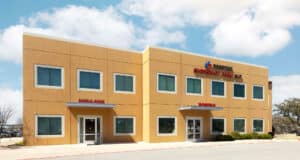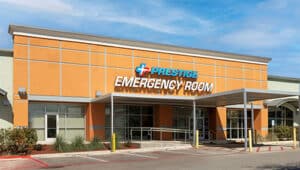When it comes to a stroke, every second matters. Recognizing the signs early and getting prompt emergency room care can save lives and prevent lasting brain damage.
At Prestige Emergency Room, we provide 24/7 stroke symptom evaluation and emergency treatment when stroke warning signs appear.
Is it a Stroke?
Wondering “Am I having a stroke?” can be terrifying, and it’s a question you should never ignore.
Strokes happen when blood flow to the brain is blocked or reduced, cutting off oxygen and causing brain cells to die within minutes.
Knowing how to recognize stroke symptoms can make all the difference in protecting yourself or someone you love.
Common Types of Strokes and Their Warning Signs
There are several types of strokes, each with unique warning signs:
- Ischemic stroke: Caused by a blood clot blocking a blood vessel in the brain (most common type).
- Hemorrhagic stroke: Caused by bleeding in the brain from a burst blood vessel.
- Transient ischemic attack (TIA): Often called a “mini-stroke,” symptoms may only last minutes but still require immediate medical attention.
Typical stroke warning signs include:
- Sudden numbness or weakness (especially on one side of the body).
- Confusion or difficulty speaking.
- Trouble seeing in one or both eyes.
- Sudden difficulty walking, dizziness, or loss of balance.
- Severe headache with no known cause.
Why Minutes Matter: The Importance of Quick Response
During a stroke, brain cells die quickly. Immediate treatment is critical — even minor delays can increase the risk of stroke-related brain damage, permanent disability, or death.
The FAST Method: A Simple Way to Spot Stroke Symptoms
When trying to figure out if it’s a stroke, the FAST method provides a quick, easy guide:
F – Face Drooping: What to Look For
Ask the person to smile.
- Is one side of the face drooping or uneven?
- Is their smile lopsided or strange?
A – Arm Weakness: Easy Tests Anyone Can Do
Ask the person to raise both arms.
- Does one arm drift downward?
- Is one arm weak or numb?
S – Speech Problems: Recognizing When Something’s Wrong
Ask the person to repeat a simple sentence.
- Is their speech slurred, garbled, or strange?
- Are they unable to speak or hard to understand?
T – Time to Call 911: Why You Shouldn’t Wait or Drive
If someone shows any FAST symptoms, call 911 immediately.
Do not drive them to the ER yourself. Emergency medical services can begin crucial stroke symptom assessment and treatment while en route to the emergency room.
Our emergency rooms are open 24/7 and ready to respond.
Other Important Warning Signs You Shouldn’t Ignore
In addition to FAST symptoms, be alert for these warning signs:
- Sudden, severe headache with no clear cause.
- Sudden vision problems (blurred or blacked-out vision).
- Difficulty walking, loss of coordination, or unexplained dizziness.
- Sudden trouble understanding speech or confusion.
If you notice any of these, err on the side of caution and visit Prestige ER immediately.
Understanding Stroke Risk Factors
Certain factors increase your risk of stroke, including:
- High blood pressure.
- Smoking.
- Diabetes.
- High cholesterol.
- Obesity.
- Family history of stroke.
- Heart disease.
- Heavy alcohol consumption.
- Age (risk increases after age 55).
Knowing your risk factors can help you stay vigilant about stroke symptoms and prioritize your health.
Important Information to Tell Emergency Responders
When emergency responders arrive, providing clear and accurate information can help save valuable time. Be prepared to share:
- When the symptoms first started.
- What symptoms you observed.
- Any existing medical conditions (such as high blood pressure, diabetes, or heart disease).
- Current medications the person is taking.
- Any known allergies.
This information can help doctors determine the best and fastest treatment plan.
Why ER Care Is Critical for Stroke Treatment
Immediate emergency room care is essential because strokes progress quickly, and brain cells begin to die within minutes.
At Prestige Emergency Room, we have the tools to:
- Quickly diagnose the type of stroke.
- Administer clot-busting medications if needed.
- Provide advanced imaging tests to assess brain damage.
- Coordinate urgent specialist care if surgery or further intervention is required.
Timely, specialized stroke treatment significantly improves recovery rates and reduces permanent neurological damage, making rapid recognition of stroke symptoms and immediate ER care essential.
Recovery and Prevention: Life After a Stroke
Many people who experience a stroke can recover and regain strength, especially with fast treatment and rehabilitation.
Recovery plans often include:
- Physical therapy.
- Occupational therapy (rehabilitation to relearn daily tasks and improve independence after stroke symptoms).
- Speech-language therapy.
- Medications to reduce future stroke risk.
- Lifestyle changes like healthier eating and regular exercise.
Preventing a second stroke is a major part of recovery. Managing your risk factors and attending follow-up appointments is crucial to long-term health.
Emergency Stroke Care in Texas
If you suspect a stroke, don’t wait, visit your nearest Prestige Emergency Room for immediate expert care.
Our emergency rooms in San Antonio are open 24 hours a day, 7 days a week, and are equipped to handle all types of stroke emergencies and more.
Locate your nearest Prestige ER stroke treatment center for immediate care when stroke warning signs appear – every minute affects recovery outcomes.












